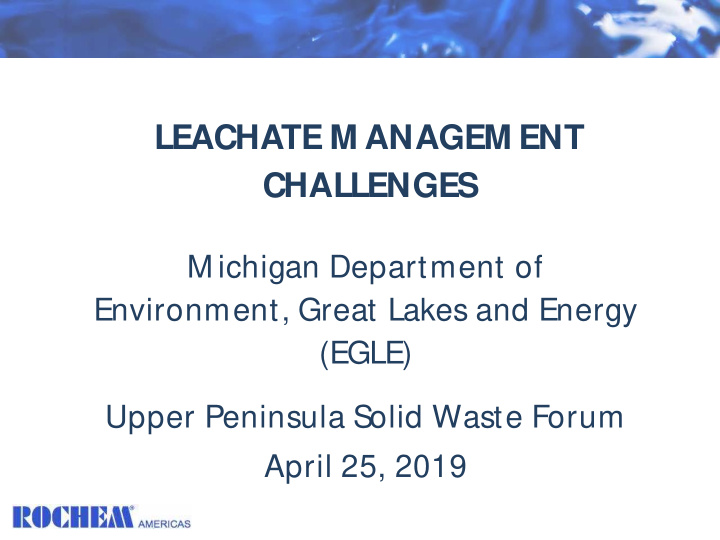



LEACHATE M ANAGEM ENT CHALLENGES M ichigan Department of Environment, Great Lakes and Energy (EGLE) Upper Peninsula Solid Waste Forum April 25, 2019
EREF Leachate M anagement Survey
M WRA Report • 32 landfills participated in study • 21 landfills discharge directly or pump/ haul to POTW • 10 landfills haul to CWT • 2 landfills haul to deep well • 1 landfill RO treatment w/surface water discharge
Emerging Leachate Issues • POTW limitations – UV transmittance • Emerging contaminants – PFAS – 1,4-dioxane – Others? • Changing waste composition
Leachate M anagement Options • M inimization • Treatment
Leachate M anagement Options • Off Site – Deep Well – Industrial / Centralized Waste Treatment – POTW
Leachate M anagement Options • On Site – Recirculation – Evaporation Source: Neptune Source: Heartland
Leachate M anagement Options • On Site – Biological – Precipitation – Oxidation – Activated Carbon – Ion Exchange – M embrane Treatment
M embrane Technology • Commercial applications since 1970s • Used for desalination of seawater and brackish water sources
Separation Process Filtration Separation
RO Block Flow Diagram Pretreatment RO1 RO2 Post Treatment Effluent Raw Leachate Concentrate
Typical RO Performance RO 1 RO 2 Parameter Units Leachate Permeate Permeate Rejection T otal Dissolved Solids mg/ L 23,800 308 16 >99% Biochemical Oxygen Demand mg/ L 392 39 3.4 99% Chemical Oxygen Demand mg/ L 9,070 163.3 2.9 >99% T otal Organic Carbon mg/ L 7,330 187 4.7 >99% T otal Suspended Solids mg/ L 57 0.80 0.0 >99% Kjeldahl Nitrogen mg/ L 7,970 841 77 >99% Ammonia-Nitrogen mg/ L 1,800 60 2 >99% Nitrate mg/ L 0.2 0.02 0.002 99% Phosphate mg/ L 5.50 0.12 0.003 >99% Zinc mg/ L 0.1 0.004 0.0002 >99% Chromium µg/ L 780 4.2 0.023 >99% Phenol µg/ L 1,100 220 34 >96% M ercury ng/ L 196 3.7 1.0 >99%
Pilot System
Leachate Treatment System
450,000 gpd Facility
Leachate Treatment System
Leachate Treatment System
Summary • Emerging leachate challenges • Leachate costs represent up to 30% of landfill operating costs • Evaluate treatment options carefully • Control your own destiny • RO is a proven and accepted technology
Thank You Paul Sgriccia, PE Rochem Americas, Inc. 248.863.7522 Paul@RochemAmericas.com www.RochemAmericas.com
Site R1 RO PFAS Rejection Results RO 1 RO 2 Compound (ng/ l) Leachate Permeate Permeate Rejection Perfluorobutanesulfonic acid (PFBS) 280 <2 <1.9 >99.3% Perfluorobutanoic acid (PFBA) 1100 5 <1.9 >99.8% Perfluoroheptanoic acid (PFHpA) 480 <2 <1.9 >99.6% Perfluorohexanesulfonic acid (PFHxS) 690 <2 <1.9 >99.7% Perfluorohexanoic acid (PFHxA) 2100 7.8 <1.9 >99.9% Perfluorooctanesulfonic acid (PFOS) 200 <2 <1.9 >99.1% Perfluorooctanoic acid (PFOA) 820 2.5 <1.9 >99.8% Perfluoropentanoic acid (PFPeA) 880 2.7 <1.9 >99.8% Total 6550 18 <1.9 >99.9%
Site N1 RO PFAS Rejection Results Compound (ng/ l) Leachate 2-Pass Effluent Rejection Perfluoro(3,5-dioxahexanoic) acid (PFO2HxA) 599 <1.19 >99.8% Perfluoro-2-methoxyacetic acid (PFM OAA) 780 <1.19 >99.8% Perfluoro-4-methoxybutanic acid (PFM OBA) 1070 <1.19 >99.8% Perfluorobutanesulfonic acid (PFBS) 1220 <0.595 >99.9% Perfluorobutanoic acid (PFBA) 2040 <0.595 >99.9% Perfluoroheptanoic acid (PFHpA) 593 <0.595 >99.9% Perfluorohexanesulfonic acid (PFHxS) 931 <0.595 >99.9% Perfluorohexanoic acid (PFHxA) 2410 <0.595 >99.9% Perfluorooctanesulfonic acid (PFOS) 228 <0.595 >99.7% Perfluorooctanoic acid (PFOA) 1250 <0.595 >99.9% Perfluoropentanoic acid (PFPeA) 1110 <0.595 >99.9% < is value below M ethod Detection Limit
Recommend
More recommend